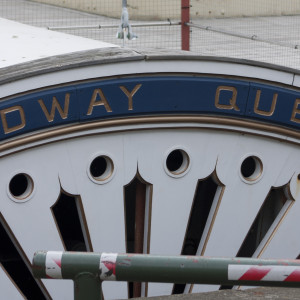Medway Queen
I dropped Jemma and Scott at Strood this morning and decided to have a drive along the river before coming home. As I came out of Gillingham I saw a sign for Gillingham Pier and another for Historic Ships and I thought I'd give it a look.
This is the Paddle Steamer Medway Queen and although the name rang a bell I had to look her up when I got home; I'm glad I did. You can read the wiki entry yourself but a brief summary is that she was built in 1924, in Scotland, to work on the Medway and the Thames estuary. At the outbreak of the Second World War she was involved in evacuating children from Kent to East Anglia and was fitted out as a minesweeper. In May 1940, equipped with a 12-pounder gun and two machine guns, she set off for Dunkirk as part of the "flotilla of little ships" which helped to scoop up the remnants of the British Expeditionary Force. She made seven trips to Dunkirk between 27th May and 3rd June and carried back about 7,000 men while shooting down 3 enemy aircraft. For this meritorious action the crew were awarded seven awards for gallantry and the ship became known as "The Heroine of Dunkirk". Reading a range of sources about the events around Dunkirk it's clear that this little ship took a lot of punishment yet it's claimed that every man they took onboard was fed and given a mug of tea or Navy cocoa. Nor was it just a mess in Dunkirk; the return to Dover coincided with an air raid.
She returned to civilian service after the war and in 1963 was retired and sent to a Belgian scrapyard. However, the Belgian ship-breaker refused to continue once he knew that this was the ship which had served so gallantly. She was sold on and became a floating nightclub on the Isle of Wight until being closed at the end of the 1970s and finally sinking on the River Medina. She was raised in the early 80s and towed to the Medway where she sank again while waiting for funding to preserve her. Since then there have been a number of narrow escapes but lottery funding was awarded and a new hull was built in Bristol.
I think that saving vessels like this helps us to remember the men who worked on her - and during the war it seems probable that the crew would have been men. Imagine the courage of the crew heading out to cross the Channel, time after time, to draw up to the beach or to enter Dunkirk harbour under enemy fire and attack from fighter aircraft. Standing next to a fragile wooden ship like this and reflecting on that environment is chastening. It's possible to visit the ship on Saturdays so I might head back to get some more photos


Comments
Sign in or get an account to comment.


